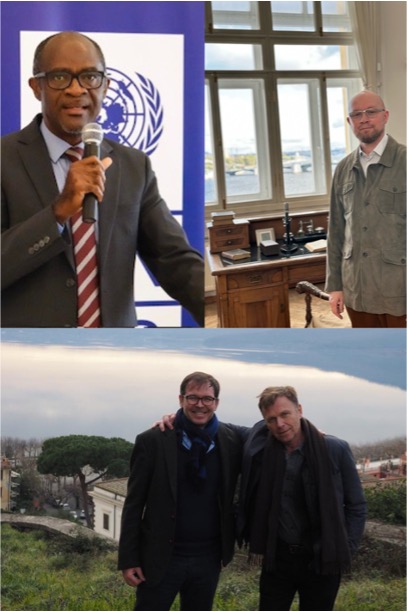Forging a Future of Social Cohesion in Ukraine
Why think about social cohesion in Ukraine now?
Ukrainian society, like many others, contends with inherent divides, such as regional disparities, socioeconomic differences, and linguistic variations. While shared history and cultural threads can act as unifying elements, wars exacerbate existing societal rifts and create new divisions. This intensifies when wars involve crimes against humanity and atrocities, as the hatred that follows makes reconciliation efforts more challenging. Post-war narratives of revenge and victimhood, if unchecked, perpetuate hostility. The social divisions that follow make recovery difficult and sow the seeds of future instability. When post-conflict reconstruction is insensitive to these societal tension fault-lines, they risk to further deepen divisions and can do harm. Given these intricacies, as Ukraine and its supporters begin to plan for recovery from the aftermath of war, it's crucial to implement strategies that not only bridge the existing divides but also celebrate the country’s shared histories and experiences.
Ukrainian society, like many others, contends with inherent divides, such as regional disparities, socioeconomic differences, and linguistic variations. While shared history and cultural threads can act as unifying elements, wars exacerbate existing societal rifts and create new divisions. This intensifies when wars involve crimes against humanity and atrocities, as the hatred that follows makes reconciliation efforts more challenging. Post-war narratives of revenge and victimhood, if unchecked, perpetuate hostility. The social divisions that follow make recovery difficult and sow the seeds of future instability. When post-conflict reconstruction is insensitive to these societal tension fault-lines, they risk to further deepen divisions and can do harm. Given these intricacies, as Ukraine and its supporters begin to plan for recovery from the aftermath of war, it's crucial to implement strategies that not only bridge the existing divides but also celebrate the country’s shared histories and experiences.
A recent mapping by local journalists from different parts of Ukraine (including areas currently under occupation) identified three key drivers of resilience and five tension fault-lines that are part of Ukraine’s current social cohesion picture.
-
Drivers of resilience in the context of social cohesion refer to those elements or factors that foster unity, stability, and a positive sense of community amidst diversity and divisions in society. These drivers facilitate the ability of communities and societies to withstand shocks and stresses.
-
A "tension fault-line" refers to underlying issues or differences within a society or community that have the potential to create discord and weaken social bonds. In delineating tension fault- lines, it must be emphasised that the term "tension" has been chosen deliberately over "conflict" due to the absence of identified conflicts at this juncture.
The mapping was part of an Improving Media Resilience in Ukraine Project, funded by Swiss Solidarity and implemented by the Fondation Hirondelle (Switzerland) and IRMI, Institute for Regional Media and Information (Ukraine).
Drivers of Resilience
-
Revitalised Patriotism and National Pride Across Ukraine, there has been a noted resurgence in patriotism and national pride, undergirded predominantly by a unifying opposition to a common adversary. This spirit of patriotism is bolstered by an unwavering belief in Ukraine’s potential for triumph in the prevailing war. It is a nationalistic fervour rooted in an avowed disdain for Russia and encourages a collective consciousness of identity and purpose.
-
Volunteer Movement and Solidarity Another significant driver of resilience has been the vibrant Ukrainian volunteer movement, characterised by remarkable solidarity. This movement is instrumental in extending support to Ukrainian fighters, internally displaced persons (IDPs), and communities in the frontlines and occupied territories. It is a cohesive force that transgresses regional and other dividing lines and facilitates not only material aid but also fosters a network of information dissemination and encouragement.
-
Shared Experiences of Hardship and Hope The collective experience of adversity in Ukraine has instilled a shared sense of hope and a deep-seated desire to rebuild and reclaim regions that have suffered occupation or destruction. This communal spirit of renewal and reconstruction will be key for a future rooted in hope and shared objectives.
Tension Fault-Lines
-
Disparities in Assistance to IDPs and Host Communities The distribution of humanitarian aid has been noted on occasions to generate tensions, as IDPs sometimes receive more assistance compared to host communities. This engenders a sense of disparity and discontent.
-
Discrepancies in Military Conscription A rural-urban divide is evident in the perceived higher conscription rates of individuals from rural communities as opposed to their urban counterparts, fostering a sense of uneven burden-sharing in some areas.
-
Divide between Leavers and Stayers The diverging paths of those who opted to leave their localities after the invasion and those who stayed behind is a point of tension, especially in newly liberated areas where differences in experiences and perspectives come to the fore. This is a tension mirrored at the national level between those who left the country and those who have stayed.
-
Language Divide The dichotomy between Ukrainian and Russian speakers represents an increasingly significant linguistic fault-line, with preferences for one over the other sometimes translating into social divides and misunderstandings.
-
Corruption Corruption is highly corrosive to social cohesion in general. In the context of war in Ukraine, it undermines efforts towards unity, manifesting detrimentally in various spheres including conscription, public procurement, aid distribution, and early recovery processes.
Under the radar
The landscape of social cohesion in war-time Ukraine is, of course, more complex. Interviews and discussions with observers highlight four less examined yet highly significant tension fault-lines in Ukrainian society:
-
Widespread Trauma The Ukrainian populace is grappling with the reverberating effects of widespread trauma, engendered by a brutal conflict characterised by atrocities and acts of terror. Anecdotal evidence suggests that this trauma pervades all levels of society, from the individual to familial, and broader societal domains. A considerable proportion of young people, especially those returning from frontlines bearing physical and psychological wounds, epitomise a growing mental health crisis facing Ukraine. There is a pressing need, therefore, for concerted efforts towards mental health rehabilitation, leveraging multidisciplinary approaches to foster healing and resilience.
-
Domestic and Gender-Based Violence Concomitant with the backdrop of war is a surge in domestic and gender-based violence, a phenomenon that remains substantially underreported albeit its pervasive acknowledgment. This issue not only fragments families but also corrodes the societal bedrock of trust and safety (see IASC, 2005). Addressing this fault- line demands a multi-pronged strategy encompassing legal reforms, sensitisation programmes, and community engagement to foster a culture of respect and equality.
-
Collaborators and Affiliations with Opposing Forces The dimensions of collaboration with Russian forces in formerly and currently occupied areas present a critical and complex facet influencing social cohesion in Ukraine. Families find themselves embroiled in divisive situations, where some may have opted for collaboration, while others have remained patriots. The subsequent treatment of collaborators and their families by Ukrainian entities not only raises moral and ethical dilemmas but also carries the potent risk of sowing seeds of deep-seated resentment and future conflicts (see Kunovich & Hodson, 1999). Hence, an empathetic, restorative justice approach needs to be considered to foster reconciliation and to navigate this intricate dynamic adeptly.
-
Reconstruction and Anti-Corruption Measures As Ukraine and its partners plan for reconstruction, there is considerable apprehension regarding the undermining role of corruption in diluting the effectiveness of funds from the West. The handling of corruption, thus, will be a defining element in either facilitating unity or fostering divisions during the recovery and reconstruction phase. A stringent, transparent governance mechanism ought to be instituted to ensure the judicious allocation and utilisation of resources, and lay a foundation of trust and collaboration as Ukraine rebuilds itself.
Social cohesion in contexts of information warfare
Ukraine is currently also fighting information warfare in both traditional and social media spaces, which has two important ramifications for social cohesion in the country.
Firstly, media narratives prevalent during wartime are characterised by polarisation, and often engender distinct and divisive binaries. It becomes imperative, therefore, to begin to strengthen narratives of unity and healing, which can uphold the societal fabric together rather than tear it apart. Collaborative endeavours involving journalists, NGOs, and the academic sector could potentially be the cornerstone in nurturing responsible and integrative reporting, one that is anchored in truth and reconciliation rather than discord (Hoskins & O'Loughlin, 2015).
As we envisage a time when the fighting stops and peace negotiations take place, the second pitfall arises from the likely Russian continuation of this information warfare, albeit in altered dynamics. The cessation of armed conflict does not invariably signal the end of informational attacks; they might transmute into other forms, continuing to sow seeds of distrust and enmity. Hence, it will be important to remain vigilant and monitor the information sphere. This involves a pro-active approach (basically “waging peace”) in the information domain involves not only countering divisive narratives but also in promoting narratives of peace, mutual respect, and unity in Ukraine (Wolfsfeld, Frosh, & Awabdy, 2016).
A call for action
In the wartime socio-political landscape of Ukraine, reinforcing social cohesion is both possible and of critical importance. It calls for a multifaceted approach, encompassing a nuanced understanding and mitigation of existing tension fault-lines alongside nurturing the drivers of resilience intrinsic to the Ukrainian society.
Key components of a social cohesion strategy for Ukraine involve:
-
Developing, at the policy level, a strategic blueprint to nurture social cohesion, particularly in liberated areas. This involves fostering unity through narratives that are inclusive, representative, and grounded in the principles of justice and reconciliation (Andrieu, 2010).
Additionally, it means acknowledging and celebrating the diverse cultural and linguistic tapestries that define Ukraine, steering clear from exclusionary narratives.
-
Working with Ukrainian authorities to tackle corruption and build conflict-sensitivity into the design and execution of aid, recovery and reconstruction efforts.
-
Crafting grounded narratives that emphasise unity and shared visions for a harmonious co- existence in the post-conflict phase. The role of educational institutions, media outlets, and community leaders will be pivotal in shaping a discourse that lays the foundations for a cohesive and resilient society in the years to come (Lederach, 2005).
-
Prioritising mental health, adopting a proactive stance to address the widespread trauma engendered by the experiences of war. This incorporates devising and implementing robust mental health policies, potentially through the collaboration of government bodies, media, and non-profit organisations, to facilitate community healing and individual recovery (Betancourt et al., 2015).
-
Curbing domestic and gender-based violence, a phenomenon exacerbated amid conflict settings (Stark & Ager, 2011). This necessitates the creation of safe spaces and support systems, bolstered by awareness campaigns that work towards a society free from violence and discrimination.
References
-
Andrieu, K. (2010). Civilizing Peacebuilding: Transitional Justice, Civil Society and the Liberal Paradigm. Security Dialogue, 41(5), 537–558.
-
Bar-Tal, D. (2007). Sociopsychological foundations of intractable conflicts. American Behavioral Scientist, 50(11), 1430-1453.
-
Betancourt, T. S., Borisova, I. I., Williams, T. P., Brennan, R. T., Whitfield, T. H., de la Soudiere, M., Williamson, J., & Gilman, S. E. (2010). Sierra Leone's former child soldiers: a follow-up study of psychosocial adjustment and community reintegration. Child development, 81(4), 1077–1095.
-
Hoskins, A., & O'Loughlin, B. (2015). War and media: The emergence of diffused war. Polity.
-
Inter-Agency Standing Committee (IASC). (2005). Guidelines for gender-based violence interventions in humanitarian settings. IASC.
-
Kunovich, R. M., & Hodson, R. (1999). Conflict, Religious Identity, and Ethnic Intolerance in Croatia. Social Forces, 78(2), 643-668.
-
Lederach, J. P. (2005). The moral imagination: The art and soul of building peace. Oxford University Press.
-
Stark, L., & Ager, A. (2011). A systematic review of prevalence studies of gender-based violence in complex emergencies. Trauma, Violence, & Abuse, 12(3), 127-134.
-
Wolfsfeld, G., Frosh, P., & Awabdy, M. T. (2016). Social media and the Arab Spring: Politics comes first. The International Journal of Press/Politics, 21(2), 239-253
 By
By


